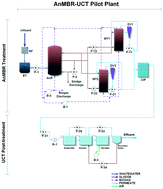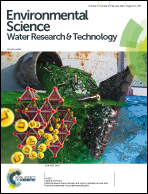Fate of endocrine disruptor compounds in an anaerobic membrane bioreactor (AnMBR) coupled to an activated sludge reactor†
Abstract
The occurrence and fate of three groups of micropollutants – alkylphenols, pentachlorophenol and hormones – were studied in a pilot plant consisting of an anaerobic membrane bioreactor (AnMBR) coupled to an activated sludge reactor (University of Cape Town configuration – UCT). Under anaerobic conditions, the octylphenol and technical-nonylphenol soluble concentrations increased producing negative degradation ratios (i.e., −175 and −118%, respectively). However, high 4-n-nonylphenol and bisphenol-A degradation ratios (92 and 59% for 4-n-nonylphenol and bisphenol-A, respectively) as well as complete pentachlorophenol, estrone, 17β-estradiol and 17α-ethinylestradiol removal were observed. Under aerobic conditions (UCT), octylphenol, technical-nonylphenol, 4-n-nonylphenol and bisphenol-A degradation ratios were higher than 84%. The AnMBR thus removes a high proportion of 4-n-nonylphenol, pentachlorophenol, estrone, 17β-estradiol and 17α-ethinylestradiol, but requires a later post-treatment process (such as UCT) to improve bisphenol-A, octylphenol and technical-nonylphenol degradation ratios. The overall AnMBR–UCT degradation ratios were 48% and 70% for octylphenol and technical-nonylphenol, respectively, and higher than 97% for 4-n-nonylphenol and bisphenol-A. The AnMBR produced a higher micropollutant accumulation in the sludge than the UCT: removal by adsorption in the AnMBR process was between 0.5 and 10%, and less than 0.5% in the UCT process. The combination of AnMBR and UCT technologies produces an effluent stream with low concentrations of micropollutants.



 Please wait while we load your content...
Please wait while we load your content...